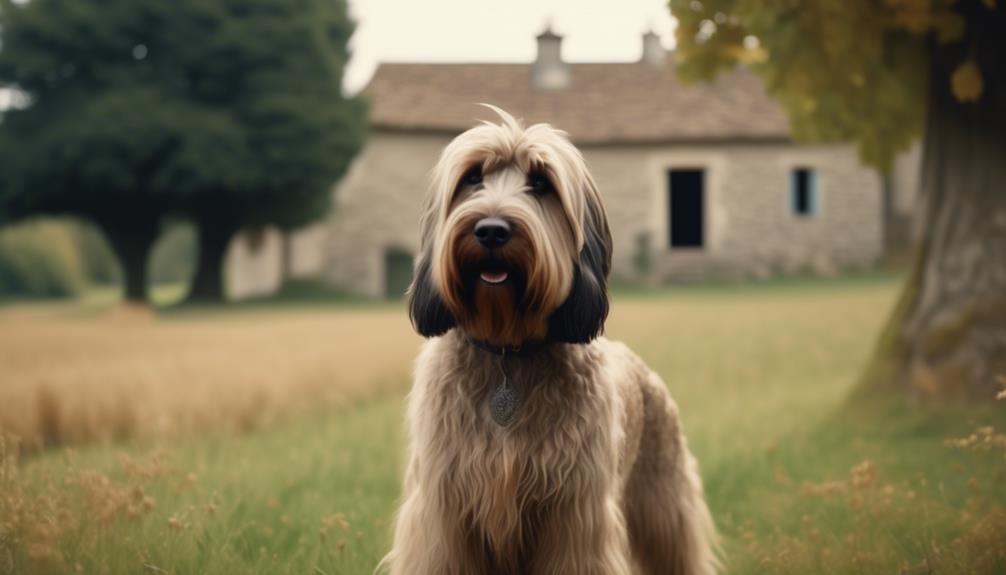Are you tired of feeling unprotected and in need of a loyal companion by your side? Look no further than the Briard.
This remarkable breed, with its roots dating back centuries, has a reputation for unwavering loyalty and a steadfast devotion to its humans.
But there’s more to this magnificent dog than meets the eye. In this discussion, we will explore the unique qualities and characteristics that make the Briard the epitome of a devoted guardian and a loyal companion.
Get ready to discover why the Briard is more than just a dog – it’s a true member of the family.
Key Takeaways
- The Briard is a medium to large breed that originated in France and has a unique and elegant appearance with a long, flowing coat and distinctive eyebrows.
- Briards are known for their intelligence, loyalty, and protective nature, making them excellent watchdogs and guardians.
- While they require daily grooming to maintain their beautiful coat, Briards are adaptable to both country and city living and can thrive in apartment settings if their exercise and mental stimulation needs are met.
- The history of the Briard dates back to the 8th century and they have been associated with notable figures such as Emperor Charlemagne and Thomas Jefferson.
Origin and History

The Briard has a rich and storied history, dating back to the 8th century in France. Its name is believed to be derived from the region of Brie in France. This breed has been linked to Emperor Charlemagne and has even been depicted in early tapestries.
Briards were the official breed of the French Army and have been associated with Napoleon. In fact, Thomas Jefferson is believed to have imported the first Briards to the United States. The Briard’s history is filled with nobility and loyalty, making it a truly remarkable breed.
With such a prestigious lineage, it’s no wonder that Briards are known for their intelligence, herding abilities, and strong protective instincts.
Appearance and Coat Care

After learning about the rich history and origins of the Briard, let’s now turn our attention to its distinctive appearance and the necessary care for its beautiful coat.
The Briard has a unique and elegant appearance, with long, flowing coats and distinctive eyebrows. To maintain their beautiful coat, here are some important care tips:
- Regular grooming: The Briard’s coat requires daily brushing to prevent matting and tangling. Regular grooming sessions will also help to keep their coat clean and healthy.
- Bathing: Briards should be bathed regularly to keep their coat and skin in good condition. Use a gentle dog shampoo and make sure to rinse thoroughly.
- Trimming: Regular trimming is necessary to keep the Briard’s coat neat and tidy. Pay special attention to the hair around their paws and ears.
- Professional grooming: Regular visits to a professional groomer are recommended to ensure that the Briard’s coat is properly maintained and trimmed.
Temperament and Personality Traits

When considering the temperament and personality traits of the Briard, you’ll find a brave, loyal, and intelligent companion. The Briard is known for its good-natured and loving nature towards its family. They thrive on participating in family activities and are essentially house dogs.
With strangers, they can be aloof, displaying their protective nature. Briards are known for their bravery and loyalty, making them excellent guardians and watchdogs. Their intelligence is evident in their ability to learn quickly and their problem-solving skills.
They’re highly adaptable and can live in both city and country environments. However, they do require daily exercise to prevent boredom and the development of destructive behaviors.
Health Considerations

To ensure the well-being of your Briard, it’s important to consider their health needs and potential conditions. Here are some health considerations to keep in mind:
- Health clearances: Make sure to obtain health clearances for conditions such as hip dysplasia, elbow dysplasia, hypothyroidism, von Willebrand’s disease, thrombopathia, and normal eyes. These clearances will help ensure that your Briard is free from these genetic health issues.
- Hip dysplasia: Briards are prone to hip dysplasia, a condition that can cause pain and lameness. Regular check-ups and proper exercise can help manage this condition.
- Elbow dysplasia: This condition results in malformed and weakened joints. Regular veterinary care and appropriate exercise can help minimize its impact.
- Congenital Stationary Night Blindness: Briards can be affected by this condition, which affects their vision. Regular eye exams can help detect and manage this condition.
Suitability for Apartment Living

Is the Briard suitable for apartment living? The Briard is a medium to large breed that can adapt well to apartment living. While size alone should not be the sole determinant, certain larger breeds, like the Briard, can thrive in apartments if their exercise and mental stimulation needs are met. Consideration of neighbors’ comfort is important, so desirable qualities in an apartment dog include being quiet and low-energy. However, high-rise settings may not be suitable for small dogs with high energy and frequent barking. To further illustrate the suitability of the Briard for apartment living, here is a table comparing the Briard’s characteristics with the requirements for apartment living:
| Characteristic | Suitability for Apartment Living |
|---|---|
| Size | Medium to large |
| Energy Level | Moderate |
| Exercise Needs | 30 to 60 minutes daily |
| Noise Level | Moderate |
| Adaptability to Space | Adapts well to apartments |
As shown in the table, the Briard’s moderate energy level and adaptability to apartments make it a suitable choice for apartment living.
Exercise and Activity Needs

The Briard’s exercise and activity needs are an important aspect to consider for their overall well-being and fulfillment. To ensure that your Briard remains happy and healthy, it’s essential to provide them with regular exercise and mental stimulation.
Here are some key points to keep in mind:
- Daily Exercise: Briards are an active breed and require at least 30 to 60 minutes of exercise every day. This can include activities such as brisk walks, jogging, playing fetch, or participating in dog sports.
- Mental Stimulation: In addition to physical exercise, Briards also need mental stimulation to keep their intelligent minds engaged. Consider providing them with puzzle toys, obedience training, or interactive games to challenge their mental abilities.
- Herding Instincts: Briards have a strong herding instinct, so activities that allow them to utilize and satisfy this instinct can be beneficial. This can include herding trials, agility courses, or even participating in herding demonstrations.
- Bonding Time: Exercise and activity time also provides an opportunity for you to bond with your Briard. Use this time to strengthen your relationship and create a deeper connection with your furry companion.
Training and Socialization

Training and socialization play crucial roles in shaping the behavior and temperament of a Briard. As a devoted guardian and loyal companion, your Briard needs proper training to ensure they’re well-behaved and obedient. Start training your Briard from a young age, using positive reinforcement techniques to encourage good behavior.
Socialization is equally important, as it helps your Briard become comfortable around different people, animals, and environments. Expose your Briard to various situations, such as walks in the park, trips to the vet, and interactions with other dogs and people. This will help them develop into a well-rounded and confident dog.
Consistent training and socialization will ensure that your Briard is a well-mannered and friendly companion.
Interaction With Children and Other Pets

When it comes to interaction with children and other pets, the Briard is known for its gentle and loving nature. Here are some key points to consider:
- Patient and Protective: Briards are patient with children and have a protective instinct, making them great companions for families.
- Playful and Loyal: They enjoy playing with children and are known to be loyal to their human siblings.
- Good with Other Pets: Briards can get along well with other pets in the household, especially if they’re properly socialized from a young age.
- Supervision is Important: While the Briard’s temperament is generally friendly, it’s always important to supervise interactions between dogs and children or other pets to ensure everyone’s safety.
With their loving nature and adaptability, Briards can make wonderful additions to households with children and other pets.
Tips for Briard Care and Maintenance

To properly care for and maintain your Briard, it’s essential to establish a consistent grooming routine.
Briards have long, flowing coats that require daily brushing to prevent matting and tangling. Regular grooming not only keeps their coat looking beautiful, but it also helps to keep their skin healthy.
In addition to brushing, you should also check and clean their ears regularly to prevent infections.
Briards are an active breed and require at least 30 to 60 minutes of exercise daily. This can include walks, playtime, or engaging in dog sports. Mental stimulation is also important, so consider providing puzzle toys or training sessions to keep their minds sharp.
Lastly, be sure to provide them with a balanced diet and regular veterinary care to ensure their overall health and well-being.
Frequently Asked Questions
Are Briards Good With Children and Other Pets?
Briards are good with children and other pets. They are brave, loyal, and intelligent, making them great companions for the whole family. Their good-natured and loving temperament allows them to thrive in family activities.
How Much Exercise Do Briards Need on a Daily Basis?
Briards need 30 to 60 minutes of daily exercise to stay happy and healthy. Engaging them in activities like walks, playtime, and dog sports will help prevent boredom and unwanted behaviors.
Do Briards Require Extensive Grooming Due to Their Long Coat?
Yes, Briards do require extensive grooming due to their long coat. Regular brushing and maintenance are necessary to prevent matting and tangling. Consider investing time and effort into their grooming needs.
Are Briards Prone to Any Specific Health Issues?
Yes, Briards are prone to certain health issues. They can suffer from hip dysplasia, progressive retinal atrophy, and other conditions. Regular health check-ups and proper care are essential to ensure their well-being.
Are Briards Difficult to Train and Socialize?
Briards are not difficult to train and socialize if you provide consistent and positive reinforcement. Start socializing them early and expose them to different people, animals, and environments. Their intelligence and loyalty make them eager learners and great companions.
Are Bull-Pei dogs as loyal as Briards?
The Bull-Pei dogs are known for their loyalty, just like Briards. Both breeds are devoted and protective to their owners. When you meet the Bullpei, you will see their strong bond with their family. They are loving and dependable companions, just like Briards.
Conclusion
Ready to add a loyal and protective companion to your life? Look no further than the Briard.
With their rich history, elegant appearance, and unwavering loyalty, these dogs make exceptional guardians and loving family members.
However, owning a Briard requires dedication to their exercise, grooming, and health needs.
If you’re up for the challenge, the Briard will reward you with a lifetime of devotion and companionship.
So, are you ready to embark on a journey with this magnificent breed?




